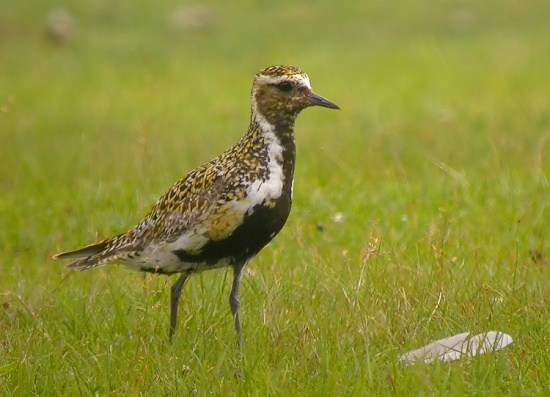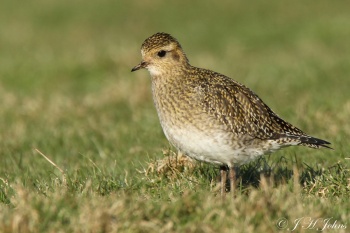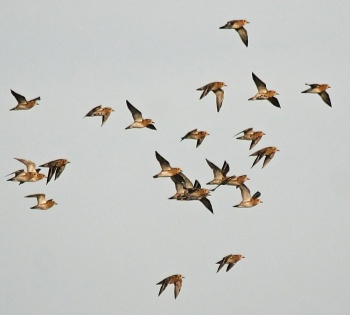(replacing redirect) |
(→External Links: Combined GSearch. Video link deleted as no longer available. GSearch checked template) |
||
| (30 intermediate revisions by 10 users not shown) | |||
| Line 1: | Line 1: | ||
| − | + | '''Alternative names: Golden Plover, Eurasian Golden Plover, European Golden-Plover''' | |
| − | [[Image:Eurasian_or_European_Golden_Plover.jpg|thumb|550px|right|Photo by Digiscoper321 <br> | + | [[Image:Eurasian_or_European_Golden_Plover.jpg|thumb|550px|right|Adult breeding plumage<br />Photo © by {{user|Digiscoper321|Digiscoper321}}<br />West [[Sweden]], 25 July 2005]] |
| − | | + | ;[[:Category:Pluvialis|Pluvialis]] apricaria |
==Identification== | ==Identification== | ||
| − | + | [[Image:Golden-plover-0103.jpg|thumb|350px|right|Adult non-breeding plumage<br />Photo © by {{user|john-henry|J. H. Johns}}<br />Camborne, [[Cornwall]], December 2010]] | |
| + | Length 26-29 cm (10¼-11½ in), wingspan 67-76 cm<br /> | ||
| + | '''Breeding adult''' is stocky with gold-on-black spangled back and cap; black face and belly with white supercilium which goes down neck along flanks; white undertail coverts. Amount of black on face and throat varies; most on northern males, least on southern females.<br /> | ||
| + | '''Non-breeding adult''' has buffy supercilium, buffy unmarked throat, and golden spotted breast grading to white belly.<br /> | ||
| + | '''Juvenile''' is very similar to non-breeding adult, differing in fine pale gold barring on the belly. <br /> | ||
| − | + | '''All plumages''' have short bill, bright golden spangled back, and white underwing coverts.<br /> | |
| + | ===Similar Species=== | ||
| + | Overall more golden coloured than the other [[:Category:Pluvialis|''Pluvialis'' plovers]].<br /> | ||
| + | [[American Golden Plover]] in all plumages has longer primary projection, darker golden coloured back, white contrasting supercilium, and grey underwing; in breeding plumage has totally black undertail coverts and belly; in nonbreeding and juvenile plumages has grey weakly barred belly and grey back with dark golden spots.<br /> | ||
| + | |||
| + | [[Pacific Golden Plover]] in all plumages has darker golden coloured back, white contrasting supercilium, slightly longer legs, and grey underwing; in breeding plumage has white on flanks with black barring; nonbreeding plumage has greyish not as defined breast markings, whitish supercilium; juvenile has yellowish wash to face, barred yellowish breast and belly markings.<br /> | ||
| + | |||
| + | [[Grey Plover]] is somewhat larger, with a longer, stouter bill, white undertail, black and white spotted back, and white uppertail coverts and rump. | ||
| + | [[Image:MG 0241 1-bf.jpg|thumb|350px|right|Non-breeding plumage in flight<br />Photo © by the late '''[https://www.birdforum.net/gallery/showgallery.php/ppuser/50827/cat/500 Mahsleb]'''<br />Southwold, [[Suffolk]], 10 February 2012]] | ||
==Distribution== | ==Distribution== | ||
| − | + | Breeds in northern [[Europe]] and northwestern [[Asia]]; winters western and southern Europe, southwestern Asia and northern [[Africa]].<br /> | |
| + | '''Europe''': [[Iceland]], [[Norway]], [[Sweden]], [[Finland]], [[Denmark]], [[Faroe Islands]], [[Greenland]] (rare), [[British Isles]], [[The Netherlands]], [[Belgium]], [[Luxembourg]], [[France]], [[Portugal]], [[Spain]] (including [[Ibiza]], [[Mallorca]], [[Canary Islands]], [[Extremadura]]), [[Switzerland]], [[Liechtenstein]], [[Germany]], [[Austria]], [[Italy]] (including [[Sardinia]]), [[Estonia]], [[Latvia]], [[Lithuania]], [[Belarus]], [[Poland]], [[Czech Republic]], [[Slovakia]], [[Hungary]], [[Slovenia]], [[Croatia]], , [[Montenegro]], [[Albania]], [[Macedonia]], [[Greece]] (including Corfu] [[Lesvos]], [[Crete]]), [[Malta]], [[Bulgaria]], [[Romania]], [[Ukraine]], [[Moldova]]<br /> | ||
| + | '''Northern Africa''': [[Morocco]], [[Algeria]], [[Libya]], [[Egypt]], cid.] | ||
| + | '''Middle East''': [[Turkey]], [[Cyprus]], [[Syria]], [[Lebanon]], [[Israel]]<br /> | ||
| + | '''Arabian Peninsula''': [[Iran]], [[Azerbaijan]], [[Georgia]]<br /> | ||
| + | '''Asia''': [[Russia]], [[Siberia]], Turkestan, [[Kazakhstan]], [[Turkmenistan]]<br /> | ||
| + | |||
| + | Vagrant in winter west to the [[Azores]] and [[Canary Islands]], south to [[Mauritania]], [[Gambia]] and east to [[Pakistan]], and in summer west to [[Newfoundland]] in [[Canada]], and north to [[Svalbard]] and Jan Mayen. | ||
| + | [[Image:Aagolden.jpg|thumb|350px|right|Flock overhead<br />Photo © by {{user|cheersm8|cheersm8}}<br />[[Cambridgeshire]], [[UK]], 20 September 2010 ]] | ||
==Taxonomy== | ==Taxonomy== | ||
| − | + | ====Subspecies==== | |
| − | + | Two subspecies are accepted by a few authors<sup>[[#References|[1]]]</sup>, but the variation is clinal with extensive intergradation, with other authorities treating the species as [[Dictionary_M-O#M|monotypic]]<sup>[[#References|[2]]]</sup>: | |
| − | + | *''P. a. altifrons'': | |
| − | + | :*Breeds east-central [[Greenland]], [[Iceland]] and [[Faeroes]] to Taymyr Peninsula. Breeding males with solid black face, breeding females with mostly black face. | |
| − | + | *''P. a. apricaria'': | |
| − | + | :*Breeds [[British Isles]] to southern [[Scandinavia]] and the [[Baltic States]]; winters [[Mediterranean]] and Persian Gulf. Breeding males with mostly black face, breeding females with little black on the face. | |
| − | + | ||
| + | The two subspecies are indistinguishable in winter and juvenile plumages. An additional subspecies ''P. a. oreophilos'' is generally considered to be invalid<sup>[[#References|[7]]]</sup>. | ||
| + | |||
==Habitat== | ==Habitat== | ||
| − | + | Breeds on moors and tundra, winters around coasts and on ploughed farmland or closely grazed grassland. | |
==Behaviour== | ==Behaviour== | ||
| − | + | ====Diet==== | |
| + | The diet includes insects, crustaceans, and berries. | ||
| + | ====Breeding==== | ||
| + | Ground nesters. The nest is usually just a hollow in the open ground, relying on the egg colouration for camouflage. The clutch consists of 4 eggs, which vary from stone-coloured through buff to pale olive; they are well marked with reddish-brown or black streaks, spots and splotches<sup>[[#References|[8]]]</sup>. | ||
| + | |||
| + | ====Vocalisation==== | ||
| + | {{ Audio|Pluvialis apricaria (song).mp3 }} | ||
| + | ''[[Media:Pluvialis apricaria (song).mp3|European Golden Plover voice clip]]'' | ||
| + | |||
| + | ==References== | ||
| + | #{{Ref-Clements6thAug18}}#{{Ref-GillDonsker18V8.2}}#Chandler, R. (2009). Shorebirds of North America, Europe, and Asia: A photographic guide. Princeton. | ||
| + | #Béchet, A. 2009. European Union Management Plan 2009-2011 for Golden Plover Pluvialis apricaria. Office for Official Publications of the European Communities, Luxembourg. | ||
| + | #Gudmundsson, G. A. (1997). - Winter distribution of Icelandic Golden Plovers Pluvialis apricaria. Bliki, 18, 55-58. | ||
| + | #Wiersma, P., Kirwan, G.M. & Boesman, P. (2018). Eurasian Golden Plover (Pluvialis apricaria). In: del Hoyo, J., Elliott, A., Sargatal, J., Christie, D.A. & de Juana, E. (eds.). Handbook of the Birds of the World Alive. Lynx Edicions, Barcelona. (retrieved from https://www.hbw.com/node/53817 on 6 October 2018). | ||
| + | #[https://avibase.bsc-eoc.org/species.jsp?avibaseid=25A20BA6F7EA9D9A Avibase] | ||
| + | #Swain, H. D. 1954. The Observer's Book of Birds' Eggs. Frederick Warne / Observer ISBN 0723200602 | ||
| + | {{ref}} | ||
| − | |||
| − | |||
| − | |||
==External Links== | ==External Links== | ||
| − | {{GSearch|Pluvialis | + | {{GSearch|"Pluvialis apricaria" {{!}} "European Golden Plover" {{!}} "Eurasian Golden Plover"}} |
| − | + | {{GS-checked}} | |
| − | [[Category:Birds]] | + | <br /> |
| + | <br /> | ||
| + | |||
| + | [[Category:Birds]] [[Category:Pluvialis]] | ||
Latest revision as of 22:15, 7 November 2022
Alternative names: Golden Plover, Eurasian Golden Plover, European Golden-Plover
- Pluvialis apricaria
Identification
Length 26-29 cm (10¼-11½ in), wingspan 67-76 cm
Breeding adult is stocky with gold-on-black spangled back and cap; black face and belly with white supercilium which goes down neck along flanks; white undertail coverts. Amount of black on face and throat varies; most on northern males, least on southern females.
Non-breeding adult has buffy supercilium, buffy unmarked throat, and golden spotted breast grading to white belly.
Juvenile is very similar to non-breeding adult, differing in fine pale gold barring on the belly.
All plumages have short bill, bright golden spangled back, and white underwing coverts.
Similar Species
Overall more golden coloured than the other Pluvialis plovers.
American Golden Plover in all plumages has longer primary projection, darker golden coloured back, white contrasting supercilium, and grey underwing; in breeding plumage has totally black undertail coverts and belly; in nonbreeding and juvenile plumages has grey weakly barred belly and grey back with dark golden spots.
Pacific Golden Plover in all plumages has darker golden coloured back, white contrasting supercilium, slightly longer legs, and grey underwing; in breeding plumage has white on flanks with black barring; nonbreeding plumage has greyish not as defined breast markings, whitish supercilium; juvenile has yellowish wash to face, barred yellowish breast and belly markings.
Grey Plover is somewhat larger, with a longer, stouter bill, white undertail, black and white spotted back, and white uppertail coverts and rump.
Distribution
Breeds in northern Europe and northwestern Asia; winters western and southern Europe, southwestern Asia and northern Africa.
Europe: Iceland, Norway, Sweden, Finland, Denmark, Faroe Islands, Greenland (rare), British Isles, The Netherlands, Belgium, Luxembourg, France, Portugal, Spain (including Ibiza, Mallorca, Canary Islands, Extremadura), Switzerland, Liechtenstein, Germany, Austria, Italy (including Sardinia), Estonia, Latvia, Lithuania, Belarus, Poland, Czech Republic, Slovakia, Hungary, Slovenia, Croatia, , Montenegro, Albania, Macedonia, Greece (including Corfu] Lesvos, Crete), Malta, Bulgaria, Romania, Ukraine, Moldova
Northern Africa: Morocco, Algeria, Libya, Egypt, cid.]
Middle East: Turkey, Cyprus, Syria, Lebanon, Israel
Arabian Peninsula: Iran, Azerbaijan, Georgia
Asia: Russia, Siberia, Turkestan, Kazakhstan, Turkmenistan
Vagrant in winter west to the Azores and Canary Islands, south to Mauritania, Gambia and east to Pakistan, and in summer west to Newfoundland in Canada, and north to Svalbard and Jan Mayen.
Taxonomy
Subspecies
Two subspecies are accepted by a few authors[1], but the variation is clinal with extensive intergradation, with other authorities treating the species as monotypic[2]:
- P. a. altifrons:
- P. a. apricaria:
- Breeds British Isles to southern Scandinavia and the Baltic States; winters Mediterranean and Persian Gulf. Breeding males with mostly black face, breeding females with little black on the face.
The two subspecies are indistinguishable in winter and juvenile plumages. An additional subspecies P. a. oreophilos is generally considered to be invalid[7].
Habitat
Breeds on moors and tundra, winters around coasts and on ploughed farmland or closely grazed grassland.
Behaviour
Diet
The diet includes insects, crustaceans, and berries.
Breeding
Ground nesters. The nest is usually just a hollow in the open ground, relying on the egg colouration for camouflage. The clutch consists of 4 eggs, which vary from stone-coloured through buff to pale olive; they are well marked with reddish-brown or black streaks, spots and splotches[8].
Vocalisation
European Golden Plover voice clip
References
- Clements, J. F., T. S. Schulenberg, M. J. Iliff, D. Roberson, T. A. Fredericks, B. L. Sullivan, and C. L. Wood. 2018. The eBird/Clements checklist of birds of the world: v2018. Downloaded from http://www.birds.cornell.edu/clementschecklist/download/
- Gill, F & D Donsker (Eds). 2018. IOC World Bird List (v8.2). doi : 10.14344/IOC.ML.8.2. Available at http://www.worldbirdnames.org/
- Chandler, R. (2009). Shorebirds of North America, Europe, and Asia: A photographic guide. Princeton.
- Béchet, A. 2009. European Union Management Plan 2009-2011 for Golden Plover Pluvialis apricaria. Office for Official Publications of the European Communities, Luxembourg.
- Gudmundsson, G. A. (1997). - Winter distribution of Icelandic Golden Plovers Pluvialis apricaria. Bliki, 18, 55-58.
- Wiersma, P., Kirwan, G.M. & Boesman, P. (2018). Eurasian Golden Plover (Pluvialis apricaria). In: del Hoyo, J., Elliott, A., Sargatal, J., Christie, D.A. & de Juana, E. (eds.). Handbook of the Birds of the World Alive. Lynx Edicions, Barcelona. (retrieved from https://www.hbw.com/node/53817 on 6 October 2018).
- Avibase
- Swain, H. D. 1954. The Observer's Book of Birds' Eggs. Frederick Warne / Observer ISBN 0723200602
Recommended Citation
- BirdForum Opus contributors. (2024) European Golden Plover. In: BirdForum, the forum for wild birds and birding. Retrieved 6 May 2024 from https://www.birdforum.net/opus/European_Golden_Plover
External Links
GSearch checked for 2020 platform.







